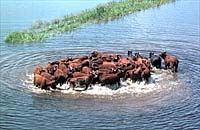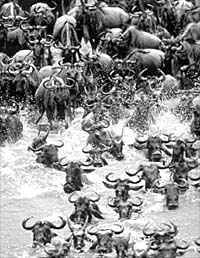 |
July 9, 2000
In the Crowd's Frenzy, Echoes of the Wild Kingdom
By NATALIE ANGIER
Agence France-Presse
Nowhere to run: scared cattle circling in Germany.
Related Article
• Science Specials and Forums
Animals Animals
There can be nothing more dangerous than a crowd. A herd of wildebeest on the move.
IGHLY social species": it sounds sweet and clever all at once, doesn't it? And there's nothing like a spell of hot weather to remind us of how much we have in common with chimpanzees, dolphins and other gregarious souls. Dining al fresco on crowded sidewalks with cell phones grafted to our ears. You scratch my back, I'll de-flea yours. Synchronized swimming, anyone?
Clearly we are party animals by nature, and proud of it. Biologists believe that the complexities of social life are what gave rise to big brains and luxurious intelligence in the first place. Highly social species are, as a rule, the smartest and most sophisticated species the planet has produced.
So why is it that there can be nothing stupider, nothing more primitive and dangerous, than a crowd of people? If human sociality has its roots in our primate past -- and it surely does -- and if the advantages of living in a group predate the evolution of Homo sapiens, it's worth asking whether the menacing side of a human crowd likewise resembles group behavior among nonhuman species.
Examples of humans behaving badly abound: a bunch of young people get together in Central Park after a parade, and the next thing you know the men are yanking the halter tops off the women, the women are screaming, and bystanders are watching from the sidelines with all the dulled wit of wildebeest. Then there was the Tailhook scandal, in which scores of women reported being assaulted by Navy and Marine Corps pilots in a Las Vegas hotel. Remember "whirlpooling," when boys in New York's public pools would surround a girl, pull off her bathing suit top and grope her, stirring the water into an artificial Jacuzzi so she couldn't escape? Or how about the crowds at European soccer matches that erupt in an almost predictable frenzy when their team loses -- or even when their team wins? Just last month, basketball fans in Los Angeles rioted after the the hometown Lakers won the N.B.A. championship.
So what makes a good crowd turn madding? And when a crowd turns mob, is it becoming more "natural," or less?
"My concern is that any discussion of similar behavior in other animals can be misinterpreted as justification, along lines of 'they can't help it, they lose control,' " said Dr. Barbara Smuts, a primatologist and anthropologist at the University of Michigan. Nevertheless, pack behavior is systematically studied in the wild, and field biologists say they have seen some rough parallels to the actions of human mobs in their observations of other social species -- among females as well as males.
In a number of species, young males travel together in what are called bachelor groups or male alliances, and those musky cliques can be a real threat to other members of their tribe. For example, among bottlenose dolphins, biologists have discovered that males aggregate into multitiered layers of alliances, from tightknit teams of two or three dolphins to super-alliances of 14 individuals or more.
Those alliances serve to spirit away fertile females from competing gangs of males, and the males, in their efforts to co-opt females, grow aggressive to the point of viciousness. They slap the females with their fins, bite them, wham them with their snouts and flip-flop around them in spectacular, synchronized dives. And the males don't restrict their group antics to the control of females. Sometimes they rabble-rouse seemingly out of boredom, or arrogance, or to show who's pasha.
Dr. Richard C. Connor, a marine biologist at the University of Massachusetts in Dartmouth, recounts a time at his research site in Shark's Bay, Australia, when he watched two alliances of dolphins get together for the equivalent of a day of wilding. The males moved through their home turf and harassed every dolphin or group of dolphins they encountered.
"They were going after females, other males, juveniles, it didn't matter," he said. "They'd mount the dolphins, or just blast into the middle of a group to blow it apart, and then they'd move on to harass somebody else. As far as I could tell, they were just being surly."
The objects of their harassment were not strangers, but members of the males' school: their friends, kin and neighbors. Males in groups pose a danger to others because group cohesion is often cemented through flamboyant displays -- of strength, of toughness, of difference and of sameness.
"For some of the activities that we see in male groups, instead of explaining it purely as males being interested in trying to mate with females, we should look at it from the perspective of males impressing other males, and being under peer pressure and trying to gain status in a hierarchy," said Dr. Frans de Waal, a primatologist at the Yerkes Regional Primate Research Center in Atlanta.
Among chimpanzees, he said, adult males often strut around intimidating others, shaking branches in the air or dropping them from trees, swinging from vines and hooting, dislodging stones and rolling them into the river. If the chimpanzees in one community greatly outnumber those of a neighboring tribe, the males of the more populous group may rile each other up enough to go on a rampage. "The males function more or less as a unit in seeking out both males and females from the neighboring community who are on their own and unprotected," said Dr. Smuts. "That's when the most severe, murderous aggression can occur."
Kinship groups are often the deadliest of all, and that includes groups of females as well as males. Among African wild dogs, for example, an alpha female and her sisters may kill the pups of more distantly related females in the group, the better to ensure that all females devote themselves unstintingly to the alpha's offspring. As for primates, the vast majority of species live in gynocentric societies, with the members of one matriline protecting one another against competing members of other matrilines. Hence, a female's worst nightmare may be not a roving band of males, but a clan of resident, ever-Machiavellian females.
Kim Wallen, a primatologist at Emory University who studies rhesus monkeys, said the deadliest moments in rhesus life occur during times of social instability, when a ruling matriline for some reason becomes weakened by the aging or death of a few key members, and a subordinate matriline spies its chance to rule.
"When we've had one of these overthrows, we've had multiple deaths in a short period of time," he said. "Seven or eight females will chase one female around and around until she drops of exhaustion, and then she's finished."
As a rule, though, the advantages of group living outweigh the dangers. Groups can be brutal, but they also offer protection against predators, aggressive neighbors and even sexual stalkers. Dr. Smuts points out that the only female primates to share with women the dubious distinction of being at risk of forced copulation -- a k a rape -- are orangutans. Female orangutans, unlike other apes and monkeys, are solitary, traveling alone or with dependent offspring. Should a female orangutan encounter a young male, he may well try to force himself on her, and being bigger, he often succeeds. Without the support of a group, she has no one to beseech, no one who might deign, however grudgingly, to come to her aid.
Quick News |
Page One Plus
| International |
National/N.Y.
| Business
| Technology |
Science | Sports | Weather | Editorial |
Op-Ed | Arts | Automobiles | Books | Diversions | Job Market |
Real
Estate | Travel
|


